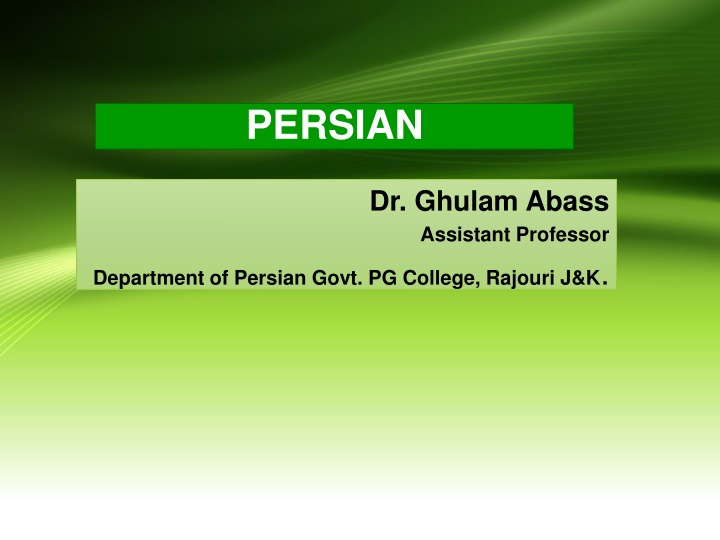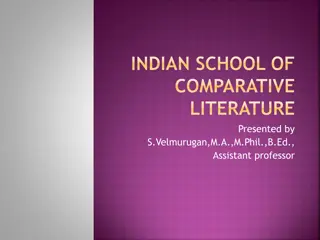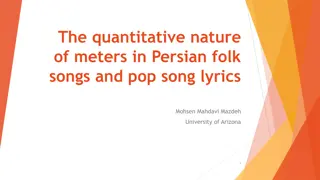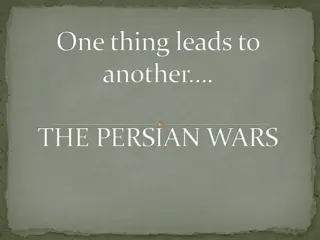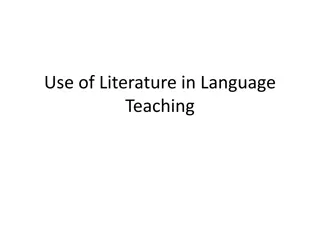Exploring the Significance of Persian Language and Literature in Indian History
Persian language and literature hold a crucial place in Indian history, serving as a prime source for understanding the medieval period. Scholars in India have dedicated their lives to preserving and promoting Persian history, language, and literature. The rich cultural heritage of India, dating back centuries, has been intricately interwoven with Persian influence, contributing to the development of art, literature, and academic research. The enduring legacy of Persian literature imparts valuable insights into life's intricacies and moral values, shaping the literary landscape of India.
Download Presentation

Please find below an Image/Link to download the presentation.
The content on the website is provided AS IS for your information and personal use only. It may not be sold, licensed, or shared on other websites without obtaining consent from the author.If you encounter any issues during the download, it is possible that the publisher has removed the file from their server.
You are allowed to download the files provided on this website for personal or commercial use, subject to the condition that they are used lawfully. All files are the property of their respective owners.
The content on the website is provided AS IS for your information and personal use only. It may not be sold, licensed, or shared on other websites without obtaining consent from the author.
E N D
Presentation Transcript
PERSIAN Dr. Ghulam Abass Assistant Professor Department of Persian Govt. PG College, Rajouri J&K.
Persian Language & Literature is a Prime source of Medieval History of India .
In our modern society there are many pieces of literature that provide an essential and practical perspective on life. India s ancient civilization is the cradle of culture and art of human being. It is always left immortal scholars and renowned personalities during the centuries. The expanded galaxy of India s civilization is supported with bright academic stars in the fields of culture, art and literature whose rays of light would never decline and degenerate. As India has encountered certain crisis but this galaxy never fell short of the stars and always gives birth to the renowned personalities who bring about pride for India s culture and civilization. The fields of sciences, literature, art and culture have developed to a great extent and created opportunities for the growth of scientific and literary research and studies in India. Among all fields, the literary field is quite different which has been considered a great source of creating morality and purifying our soul. The best example of the literary values is the Persian literature which teaches us the different etiquette of life.
There are many scholars who have written magnificent works which are the consequences of a life time hard work in the shape of Persian history, language and literature.This signifies the importance of Persian Language and literature among the learned and academicians of India, who find the Persian language and literature dignified and highly esteemed. Undoubtedly a major part of the historical resources in India has been written in Persian language and as long the old manuscripts of these resources are not known, edited and published so the history of India may not be known appropriately. The efforts of all those scholars who have identified and recognized this factor and had invested their best skills for academic edition of the historical books of India, are worth appreciation. Appreciating their efforts is not only paying homage to a sincere, meticulous and hardworking scholars, but also taking a pace in safe-guarding the historical heritage of India, which is deeply concerned with Persian language and literature in India.
Persian is one of the oldest living languages of the world. It is a well- known rich cultured and equally glorious literary language, its origin has been traced earlier than 1500 B.C. but with the passage of time it has also undergone many changes.The Persian language, also known as Farsi, or Parsi is an Indo European language spoken in Iran (Persia), Afghanistan, Tajikistan and by minorities in Uzbekistan, Turkmenistan, Azerbaijan, Georgia, Southern Russia, Behrain, Israil, Oman, Yemen, UAE, U.S.A. and in some other parts of the neighboring countries. It is spoken in Pakistan and some parts of India also. Though, Persian and its varieties have an official- language status in Iran, Afghanistan, and Tajikistan. But historically it has been considered as the most important understood language from the Middle East to India. After being derived from the language of the ancient Persian people it become a part of the Indo-Iranian language.
There are approximately 200 million native speakers of Persian language around the world. Persian language made its formal relation with India in eleventh century when Ghaznavid and Turkish Ghurids established their powers in Punjab. And by the time of conquest on north India in twelfth century, Persian evolved as a literary language throughout Central Asia. Under the patronage of Delhi Sultans, Persian writers, scribes, and poets become more active when Sikandar Lodi (1488-1517) completely Persianised the administration. After Sultans, the Mughal Empire brought a new era in Indo-Persian literature during which the eminent Persian scholars and poets had added a most important chapter of the history of Persian language and literature to the world history which starts from Babar.
Particularly in the reign of Akbar (1556-1605), there was a developing process of the Persian literary culture in a large part of India, then Persian became the first language of the king and the court, Akbar formally declared it as the language of the Mughal administration at all levels. It thus become an important tool for career advancement, particularly in the civil services, thus several poets came from Persia to India and joined his Court. Dara Shikoh did much to harmonize Hindu and Islamic religious ideals. His Sirr-i- Akbar contains a Persian rendering of fifty-two Upanishads, no doubt the whole Mughal period was the flourishing period of Persian development, but Emperor Akbar s period has been considered as the golden period and literature along with art and culture was desirably developed. in which the Persian language
Besides this many varieties of the literature were produced because Akbar s secular behavior motivated him for preserving and exploring not only the manuscripts, books and scriptures of any particular sect or religion but he worked for the welfare of the humanity as a whole. In India if we leave out the re-telling of the stories of the Ramayana and the Mahabharata in regional languages, the first significant translations, to my knowledge, took place at the time of Emperor Akbar in Persian. Apart from this he created a genuine way to translate the Sanskrit, Turkish and Arabic texts into Persian by setting up a Maktabkhana or translation bureau. Persian translation of Sanskrit texts included Ramayana, Mahabharata, Bhagvad-Gita, Bhagavat Purana, Atharva Veda, Yoga Vashisht etc. These translations can be characterised as a dialogue of civilization.
After taking off the prejudiced glasses no one can hesitate to say that, until recent centuries, Persian was culturally and historically one of the most prominent languages of the Middle East and regions beyond. Its literature is certainly one of the most significant civilization encounter in history, making possible the emergence of personalities like Raja Ram Mohan Roy, Who was a truly multilingual scholar, firstly sent to Patna by his father Ramakanto to study the Persian and Arabic in a Madrasa, after that he went to Banaras (Kashi) for learning the intricacies of Sanskrit and Hindu scriptures, including the Vedas and Upanishads.
